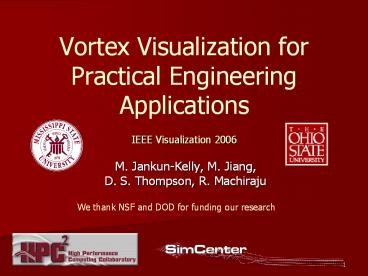Vortex Visualization for Practical Engineering Applications IEEE Visualization 2006
Title:
Vortex Visualization for Practical Engineering Applications IEEE Visualization 2006
Description:
Vortex Visualization for Practical Engineering Applications. IEEE Visualization 2006 ... These techniques work on practical data: large, noisy, unstructured, ... –
Number of Views:93
Avg rating:3.0/5.0
Title: Vortex Visualization for Practical Engineering Applications IEEE Visualization 2006
1
Vortex Visualization for Practical Engineering
ApplicationsIEEE Visualization 2006
- M. Jankun-Kelly, M. Jiang,
- D. S. Thompson, R. Machiraju
We thank NSF and DOD for funding our research
2
Overview
- Goal Feature Based Vortex Visualization
- Challenge Practical Engineering Data
- Existing Techniques
- Our Method
- Results Conclusions
- Ongoing Work
3
Feature Based Vortex Visualization
Vortex visualization schematic wing
(green),vortex core line with sense of rotation
(twisted ribbon), vortex extent local
tangential velocity (shaded surface)
- Vortex a swirling flow feature
- Characterization high level feature description
4
Practical Engineering Data
- large
- unstructured mesh
- low level
- noisy
- complex vortical flows
- resolution
spinning missile with dithering canards Blades
Marcum 2004
serrated wing Hammons 2006
5
Existing Techniques
- Region Based
- Vorticity magnitude
- Swirl parameter Berdahl
Thompson 1993 - ?2 Jeong Hussain 1995
swirl parameter isosurfacing
- Line Based
- Sujudi Haimes method (line segments)
1995 - streamlines from critical points
- Banks Singer method 1995
- Jiangs combinatorial method 2002
- Sahner/Weinkauf/Hege ?2 and scalar field method
2005
core line segments Sujudi Haimes 1995
- Feature Based
- Stegmeier et al. 2005
- Garth, Laramee, Tricoche et al. 2005
- Tricoche et al. 2005
streamlines
6
Overview of Our Method
- Vortex detection
- Topology Identification
- Core line extraction
- Extent computation
- Characteristics are found in stages 3,4.
1
2
3
4
7
Stage 1 Vortex Detection
- Vortex detection
- Topology Identification
- Core line extraction
- Extent computation
- Characteristics are found in stages 3,4.
1
2
3
4
8
Vortex DetectionLocal Extrema Method (LEM)
Scalar field whose extrema coincide with vortex
core lines
Detection of line-type local extrema
Vortex core candidate cells
9
Vortex Detection Aggregation
low level data (candidate cells)
high level data (aggregates)
Aggregation moves the level of abstraction from
mesh data towards feature data.
10
Stage 2 Topology Identification
- Vortex detection
- Topology Identification
- Core line extraction
- Extent computation
- Characteristics are found in stages
3,4.
1
2
3
4
11
Topology Identification
N vortices per aggregate, branching
Aggregates are split into non-branching pieces
with a k-means clustering algorithm.
1 vortex per aggregate, no branching
(feature level data)
12
Stage 3 Core Line Extraction
- Vortex detection
- Topology Identification
- Core line extraction
- Extent computation
- Characteristics are found in stages 3,4.
1
2
3
4
13
Core Line Extraction
The correction step locates the extreme value at
the core line in the swirl plane.
One core line is extracted from each
aggregate
with prediction / correction.
14
Correction Step Function Fitting
- Goal locate extreme value in the swirl plane
- 2D conical fitting function, one extreme value
expected - Best fit minimal standard deviation of fit error
(red high, blue low) - Locate vortex core line with subcell resolution
known function sample point local extremum (not a
data point) predicted local extremum
15
Stage 4 Extent Computation
- Vortex detection
- Topology Identification
- Core line extraction
- Extent computation
- Characteristics are found in stages 3,4.
1
2
3
4
16
Vortex Extent
Dacles-Mariani 1995
vortex core lines
extent is the surface of maximum tangential
velocity
vortex extent surfaces
17
Feature Based Visualization Serrated Wing
visualization result
- Extent purple surface
- Core lines ribbons
- Rotation sense ribbon twist
- Circulation ribbon color
visualization goal schematic
18
Feature Based Visualization Spinning Missile
19
Feature Based Visualization Spinning Missile
Movie
20
Timing on Sun UltraSPARC III
Dataset Mesh Size (nodes) Feature Count Feature Extraction Time
Serrated wing 900,000 25 lt 2 min
Spinning missile 9 million 1,800 33 min
Bronchial tube 12 million 800 11 min
Helicopter rotor 10.2 million 172 22 min
(12 min on Apple XServe G5)
21
Conclusions
- Vortex core lines resolved through novel function
fitting technique - Individual vortices identified with novel k-means
technique - These techniques work on practical data
large, noisy, unstructured, not ideally sampled - Feature based visualization of interesting,
complex vortex behavior made possible
22
Ongoing Work
- Improve Core Line Quality
- reduce swirl vector field noise
- improve local extremum detection
- repair C0 discontinuities
- Improve Extent Quality
- local repair of outliers
- better extent model
23
Questions?
Monika Jankun-Kelly mjk_at_erc.msstate.edu































